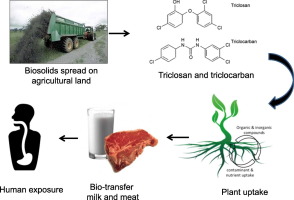Food Research International ( IF 8.1 ) Pub Date : 2017-12-30 , DOI: 10.1016/j.foodres.2017.12.072 Rachel Clarke , Mark G. Healy , Owen Fenton , Enda Cummins

|
The use of biosolids as a fertiliser may be an indirect route for contaminants into the food chain. One of the main concerns regarding the spreading of biosolids on agricultural land is the potential uptake of contaminants into plants which may bio-transfer into grazing animals that supply the food chain directly (e.g. meat and milk) and hence are subsequently consumed. The aim of this project was to create a quantitative risk assessment model to estimate the fate and translocation of triclosan (TCS) and triclocarban (TCC) into the feed (grass) and food chain with subsequent human exposure. The model's results indicate that TCS and TCC have low potential to transfer into milk and beef following the ingestion of contaminated grass by dairy cows. Mean estimated TCS and TCC residues in milk and beef show that TCC had the greatest concentration (mean values of 7.77 × 10− 6 mg kg− 1 in milk and 1.36 × 10− 4 mg kg− 1 in beef). Human exposure results show that TCC was greater for milk consumption in infants (1–4 years) (mean value 1.14 × 10− 7 mg kg− 1 bw d− 1) and for beef consumption by teens (12–17 years) (mean value 6.87 × 10− 8 mg kg− 1 bw d− 1). Concentrations of TCS and TCC were well below the estimated acceptable daily intake (ADI). Human health risk was estimated by evaluation of the hazard quotient (HQ), which used the NOAEL as a toxicity endpoint, combined with milk and beef human exposure estimates. HQ results show that all values were < 0.01 (no existing risk). A sensitivity analysis revealed that the Kow and initial concentration in biosolids as the parameters of greatest importance (correlation coefficients 0.91 and 0.19, respectively). This highlights the importance of physio-chemical properties of the compounds and their detection in biosolids post wastewater treatment along with their persistence in soil following application. This model is a valuable tool in which to ascertain the potential transfer of contaminants in the environment into animal forage with knock on consequences for exposure through the human food chain.
中文翻译:

应用于农田的生物固体中抗菌剂的定量风险评估以及潜在转移到食物中的可能性
使用生物固体作为肥料可能是污染物进入食物链的间接途径。关于生物固体在农业土地上扩散的主要关注之一是污染物可能被植物吸收,这些污染物可能被生物转移到直接供应食物链的放牧动物(例如肉和牛奶)中,并因此被消耗掉。该项目的目的是创建一个定量的风险评估模型,以评估三氯生(TCS)和三氯卡班(TCC)在饲料(草)和食物链中的命运和易位性,并随后暴露于人类。该模型的结果表明,在奶牛摄入受污染的草之后,TCS和TCC转化为牛奶和牛肉的可能性很低。- 6 毫克公斤1 -乳和1.36×10 - 4 毫克公斤1 -牛肉)。人体暴露结果表明,对于TCC婴儿牛奶消费量(1-4岁)更大(平均值1.14×10 - 7 毫克公斤- 1个 BW d - 1),并用于通过青少年(12-17岁)牛肉消耗(平均值6.87×10 − 8 mg kg − 1 bw d − 1)。TCS和TCC的浓度远低于估计的每日可接受摄入量(ADI)。通过使用NOAEL作为毒性终点的危险商(HQ)评估以及牛奶和牛肉的人暴露估计值来评估人类健康风险。总部结果显示,所有值均<0.01(无现有风险)。敏感性分析表明,Kow生物固体中的初始浓度和初始浓度是最重要的参数(相关系数分别为0.91和0.19)。这突出了这些化合物的理化特性及其在废水处理后的生物固体中检测以及其在施用后在土壤中的持久性的重要性。该模型是一种有价值的工具,可用于确定环境中污染物向动物饲料中的潜在转移,从而对通过人类食物链暴露的后果产生影响。


























 京公网安备 11010802027423号
京公网安备 11010802027423号